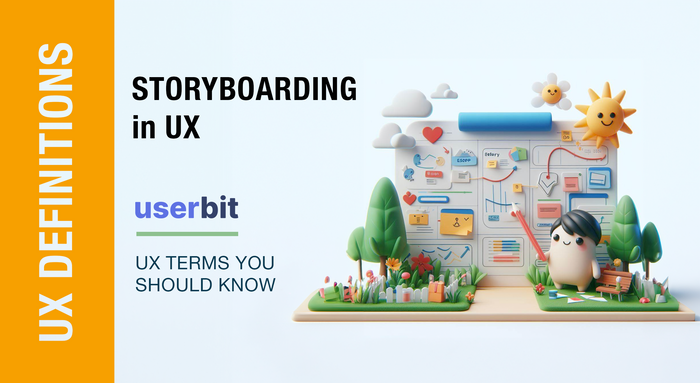
What is a UX Storyboard?
It’s a great day for all of our visual learners out there.
Today, we’re here to talk about storyboarding in UX, a method that allows designers to immerse themselves in the user's perspective and empathize with their needs, frustrations, and aspirations.
Below, we'll explore how storyboards offer a visual narrative of user experiences by enhancing understanding and driving creativity in the design process.
What is storyboarding in UX?
Think of storyboarding as a series of illustrated panels or images that depict each step the user takes, much like a comic strip. These panels represent the moments when users engage with a product.
Simply put, storyboarding helps designers see and explain how users move through a product or service step by step. It organizes the user journey into a clear sequence, showing important actions, decisions, and feelings along the path.
This method helps everyone involved understand the user's experience better, making it easier to design products that meet their needs and expectations.
Why use storyboarding?
Storyboarding offers several benefits in a UX design setting. Firstly, it provides a tangible visual representation of the user's journey so it’ll be easier for designers to identify pain points, gaps, or opportunities for improvement.
By mapping out different scenarios, designers can anticipate user behavior and design more intuitive and user-friendly interfaces.
Secondly, storyboarding serves as a communication tool that allows designers to effectively convey their ideas to stakeholders, developers, and other team members.
For example, instead of relying solely on verbal descriptions or written reports, storyboards provide a vivid and engaging way to illustrate design concepts and user flows.
Moreover, storyboarding can help streamline the design process by enabling designers to iterate quickly and test various design solutions.
By visualizing different scenarios, designers can evaluate the effectiveness of their designs and make informed decisions about which direction to pursue.
Key elements of a UX storyboard
In UX storyboarding, three main parts help us create a clear picture of how users interact with a product:
1. User scenario
This is the main story we're telling. It shows step-by-step how a person uses the product or service.
2. User persona
Choosing our user persona is like picking the main character in our story with a goal of narrowing down who the user is, what they want, and why they do what they do.
3. Visual captions
These are short descriptions near each picture. They explain what's happening in the picture – like the user’s feelings, environment, emotional state, device, and so forth so that it’s easier for team members and stakeholders to understand the given scenario.
By focusing on these parts, we can create a UX storyboard that's easy to follow and helps us design products that meet users' needs.
What are the benefits for UX professionals?
For UX professionals, storyboarding serves as a powerful tool for translating abstract ideas and concepts into tangible visual representations.
A great storyboard can bridge the gap between user research and design implementation by offering a structured framework for ideation, iteration, and validation.
By creating storyboards, UX professionals can:
1. Visualize user interactions
Storyboards provide a visual narrative of how users interact with a product or service, highlighting key touchpoints, decision points, and pathways.
2. Identify pain points
By depicting the user's journey step-by-step, designers can identify potential pain points, friction areas, and usability issues that may hinder the user experience.
3. Communicate design concepts
Storyboards serve as a communication tool, enabling designers to effectively convey their design concepts, ideas, and solutions to stakeholders, clients, and team members.
4. Iterate and refine designs
Storyboarding facilitates rapid iteration and refinement of design solutions. Designers can experiment with different scenarios, gather feedback, and iterate on their designs to create optimal user experiences.
5 steps to create a UX storyboard
Making a UX storyboard follows a structured process:
1. Gather data
Begin by collecting relevant data, including user interviews, usability tests, or site metrics, to inform the storyboard narrative.
2. Define the fidelity level
Are we going with stick figures or Picasso-level art today? Determine the fidelity level based on the audience and goal of the storyboard, ranging from simple sketches to detailed illustrations.
3. Define the basics
Specify the persona and scenario represented in the storyboard by ensuring clarity and focus on a single user path.
4. Plan your steps
Outline the sequence of steps and emotional states of the user by writing out your scenario before using any storyboard template.
5. Create visuals and add captions
Generate visuals depicting each step of the user journey, accompanied by concise captions providing context and detail.
6. Distribute and iterate
Share the storyboard with stakeholders for feedback and iterate as necessary to refine the narrative and enhance clarity.
Journey mapping vs storyboarding
While both journey mapping and storyboarding are valuable tools in UX design, they serve slightly different purposes and are used at different stages of the design process.
First of all, journey mapping focuses on the holistic user experience by mapping out the user's entire journey from start to finish. Think big picture. It provides a broad overview of the user's interactions across various touchpoints to help designers identify key moments of engagement and potential pain points.
Storyboarding, on the other hand, zooms in on specific interactions or scenarios within the user journey. It provides a detailed visual representation of how the user interacts with a particular feature or aspect of the product by allowing designers to explore different design solutions and anticipate user behavior.
To sum it up, while journey mapping is ideal for understanding the overall user experience and identifying opportunities for improvement, storyboarding is more focused on designing and refining specific interactions or features.
How UserBit can help
While distinct from storyboarding, journey mapping is an important component of the UX design process. UserBit's journey mapping feature enables designers to visualize the end-to-end user experience, identify key touchpoints, and understand the user's emotional journey.
By mapping out different user pathways and interactions, designers can uncover opportunities for improvement and create more intuitive and user-friendly designs.
Besides journey mapping tools, UserBit also offers user persona creation, user research management, and more, making it a comprehensive solution for UX designers and teams.
UserBit also supports an iterative design process, so that designers can continuously refine and improve their designs based on user feedback and insights.
By integrating user research, persona development, journey mapping, and design iteration within a single platform, we’re here to help you streamline the design process and ensure that your final product meets user needs and expectations.


